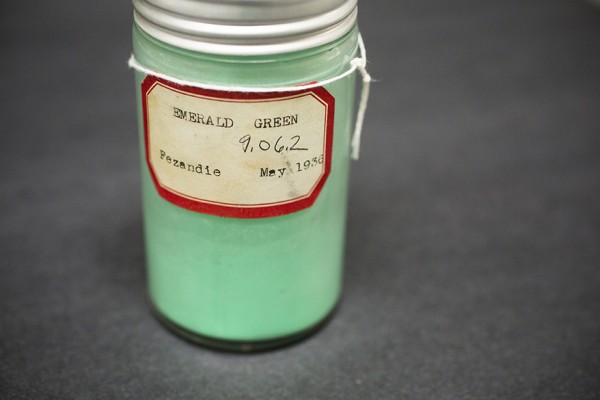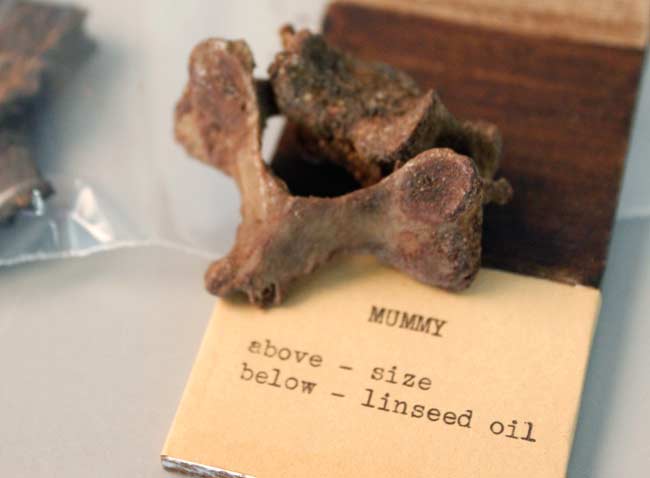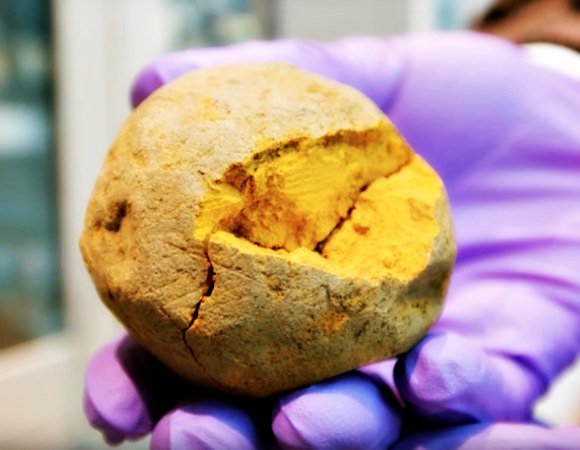If modern paint companies’ pretentiously-named color palettes gall you to the point of an exclusively black-and-white existence, the Harvard Art Museums’ Forbes pigment collection will prove a welcome balm.
The hand and typewritten labels identifying the collection’s 2500+ pigments boast none of the flashy “creativity” that J. Crew employs to peddle its cashmere Boyfriend Cardigans.

Images by Harvard News
The benign, and wholly unexciting-sounding “emerald green” is —unsurprisingly—the exact shade legions of Oz fans have come to expect. The thrills here are chemical, not conferred. A mix of crystalline powder copper acetoarsenite, this emerald’s fumes sickened penniless artists as adroitly as they repelled insects.
Look how nicely it goes with Van Gogh’s ruddy hair…

“Mummy” is perhaps the closest the Forbes collection comes to 21st- century pigment naming. As Harvard’s Director of the Straus Center for Conservation and Technical Studies, Narayan Khandekar, notes in the video above, its mushroom shade is no great shakes. The source—the resin used to seal mummies’ bandages—is what distinguishes it.

The collection’s crown jewel is a rich ball of mustard‑y Indian Yellow. This pigment comes not from maize, nor earth, but from the dehydrated urine of a cow subsisting exclusively on mango leaves. I’m drawn to it like a moth to the living room walls. I’m sure Benjamin Moore had his reasons for dubbing its urine-free facsimile “Sunny Days.”

The images above, save the Van Gogh painting, comes courtesy of by Harvard News. The video above was created by Great Big Story.
Related Content:
How Ink is Made: A Voluptuous Process Revealed in a Mouth-Watering Video
Watch the First 10 Seasons of Bob Ross’ The Joy of Painting Free Online
Ayun Halliday is an author, illustrator, and Chief Primatologist of the East Village Inky zine. Follow her @AyunHalliday


blah
L.S. Non of the pigments that where shown in the little movie are unknown to me. Probably everyone who has deeper interesse in paint wil know them too. Perhaps not the recipe that was followed to make pigments, but its quite easy to find the. Victoria Finlay wrote The Brilliant History of Color in Art, an interesting book for those who like to know more about the history of pigment en color.
Furthermore, most pigments are available at any professional art supply shop. The somewhat traditional manufacturers are still producing colors with classic pigments. Goto examples like Windsor and Newton, Lefranc et Bourgeois, Old Holland (dutch name Scheveningen olieverf) http://www.oldholland.com. These manufacturers are never shy about giving deeper information about their products. Beside the biological chemical and historical knowledge about color, their cultural, economical, emotional meaning has been thoroughly studied by John Gaga, British art historian, professor at the University of Cam
bridge.
So there is a lot more to say about pigments and color
Rob Steenhorst
Ok, so yes, I have been long interested in paint and pigments, and having been around the block a few time, have no small knowledge of my beloved medium.
But the Harvard Collection is no less impressive. and that introduction lamenting the modern habit of droll color names was enough to set the hook.
No product namedropping required.